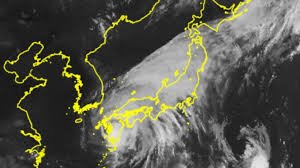Typhoon Shanshan Makes Landfall on Japan’s Kyushu Island
Typhoon Shanshan’s Impact on Kyushu Island
Typhoon Shanshan, a powerful storm, has made landfall on Kyushu Island, Japan’s southernmost main island. The typhoon, classified as a Category 3 storm, struck the island with strong winds and heavy rain, causing significant disruption across the region. Residents have been urged to stay indoors and prepare for potential flooding and landslides. The Japan Meteorological Agency (JMA) has issued severe weather warnings, highlighting the potential for extreme weather conditions as Shanshan moves across the island.
Extent of Damage and Response Measures
Initial reports indicate widespread damage to infrastructure, including power outages and transportation disruptions. The Japanese government has mobilized emergency response teams to assist with rescue and relief efforts. The focus is on ensuring the safety of residents, particularly in areas most affected by flooding and landslides. Temporary shelters have been set up to provide refuge for those displaced by the storm. The response includes restoring essential services and assessing the full extent of the damage.
Preparation and Evacuation Efforts
In anticipation of Typhoon Shanshan, local authorities implemented precautionary measures, including evacuation orders for high-risk areas. Residents were advised to secure their homes and stock up on essential supplies. The government’s preparedness efforts aimed to mitigate the impact of the storm and ensure a swift response to any emergencies that might arise. Public awareness campaigns were conducted to inform people about safety protocols and the importance of adhering to evacuation orders.
Current Situation and Forecast
As Typhoon Shanshan continues its path, weather forecasts predict that the storm will gradually weaken. However, the JMA cautions that the remaining effects could still be severe, with the potential for continued heavy rainfall and strong winds. The situation remains dynamic, with ongoing monitoring and updates provided to keep residents informed and safe. Authorities are closely watching the storm’s progression and are ready to adjust their response strategies as needed.

Why This News is Important
Understanding the Impact on Kyushu Island
Typhoon Shanshan’s landfall on Kyushu Island is significant due to its potential to cause widespread damage and disruption. The island, being a major residential and economic area, is crucial to Japan’s infrastructure. The impact of such a storm can affect daily life, transportation, and essential services, making it a critical event for both local and national responses.
The Role of Emergency Preparedness
This news highlights the importance of emergency preparedness and response measures. Japan, being prone to natural disasters, places a strong emphasis on readiness and swift action. The measures taken before and after Typhoon Shanshan’s landfall exemplify the country’s approach to managing such crises and ensuring the safety of its citizens.
Implications for Disaster Management
The storm’s impact provides valuable insights into disaster management practices and their effectiveness. Analyzing the response to Typhoon Shanshan can offer lessons for future preparedness and response strategies. It underscores the need for continuous improvement in disaster management to handle similar events more efficiently.
Historical Context
Japan’s Experience with Typhoons
Japan has a long history of dealing with typhoons due to its geographical location in the Pacific Ocean, a region prone to such storms. Historically, the country has experienced numerous typhoons that have caused substantial damage and loss of life. Japan’s response to these events has evolved over time, with advancements in forecasting, emergency preparedness, and infrastructure resilience.
Typhoon Shanshan’s Predecessors
Typhoon Shanshan follows a series of significant typhoons that have impacted Japan in recent years. Each storm provides valuable data for improving forecasting and response strategies. By understanding past events, Japan has been able to enhance its disaster management systems and better protect its population from the effects of such storms.
Key Takeaways from Typhoon Shanshan’s Landfall
| Serial Number | Key Takeaway |
|---|---|
| 1 | Typhoon Shanshan made landfall on Kyushu Island, causing significant damage. |
| 2 | Emergency response teams have been mobilized to assist with relief efforts and restore services. |
| 3 | Local authorities implemented evacuation orders and precautionary measures to mitigate the storm’s impact. |
| 4 | The Japan Meteorological Agency continues to monitor the storm and provide updates on its progression. |
| 5 | The event highlights the importance of disaster preparedness and response in managing natural disasters effectively. |
Important FAQs for Students from this News
1. What is Typhoon Shanshan?
Typhoon Shanshan is a powerful storm that made landfall on Kyushu Island, Japan. It is classified as a Category 3 typhoon, characterized by strong winds and heavy rainfall, which can cause significant damage and disruption.
2. What areas did Typhoon Shanshan impact?
Typhoon Shanshan primarily impacted Kyushu Island, Japan’s southernmost main island. The storm caused damage to infrastructure, power outages, and transportation disruptions in the affected region.
3. What measures were taken to prepare for Typhoon Shanshan?
Local authorities issued evacuation orders for high-risk areas and implemented precautionary measures, including public awareness campaigns and preparations for potential flooding and landslides.
4. How is the Japanese government responding to the storm?
The Japanese government has mobilized emergency response teams to assist with rescue and relief efforts. This includes setting up temporary shelters, restoring essential services, and providing ongoing updates to keep residents informed.
5. What is the current status of Typhoon Shanshan?
As of the latest updates, Typhoon Shanshan is expected to gradually weaken. However, the Japan Meteorological Agency continues to monitor the storm’s progression and warns of possible severe weather conditions.
Some Important Current Affairs Links


















